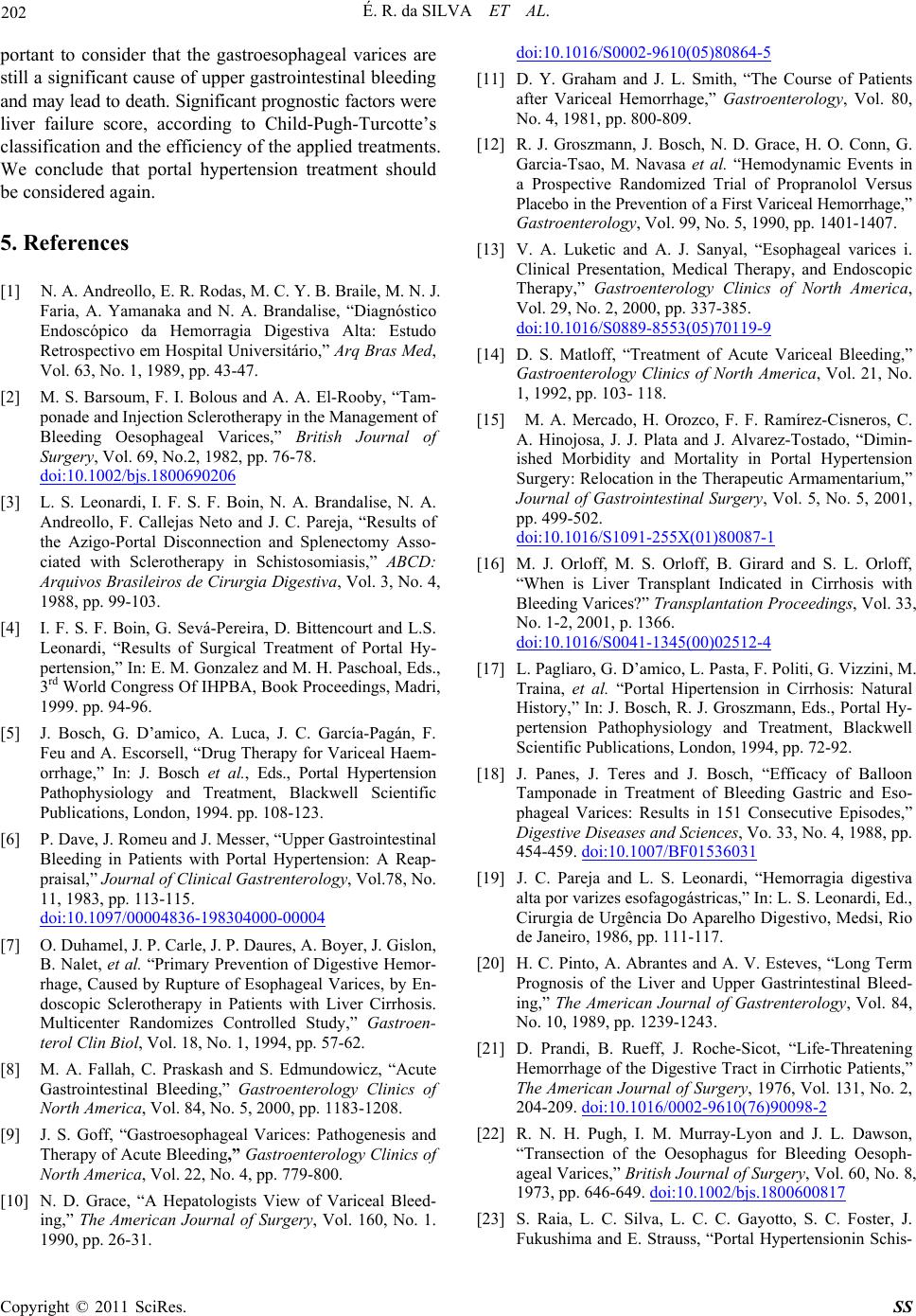
202 É. R. da SILVA ET AL.
portant to consider that the gastroesophageal varices are
still a significant cause of upper gastrointestinal bleeding
and may lead to death. Significant prognostic factors were
liver failure score, according to Child-Pugh-Turcotte’s
classification and the efficiency of the applied treatments.
We conclude that portal hypertension treatment should
be considered again.
5. References
[1] N. A. Andreollo, E. R. Rodas, M. C. Y. B. Braile, M. N. J.
Faria, A. Yamanaka and N. A. Brandalise, “Diagnóstico
Endoscópico da Hemorragia Digestiva Alta: Estudo
Retrospectivo em Hospital Universitário,” Arq Bras Med,
Vol. 63, No. 1, 1989, pp. 43-47.
[2] M. S. Barsoum, F. I. Bolous and A. A. El-Rooby, “Tam-
ponade and Injection Sclerotherapy in the Management of
Bleeding Oesophageal Varices,” British Journal of
Surgery, Vol. 69, No.2, 1982, pp. 76-78.
doi:10.1002/bjs.1800690206
[3] L. S. Leonardi, I. F. S. F. Boin, N. A. Brandalise, N. A.
Andreollo, F. Callejas Neto and J. C. Pareja, “Results of
the Azigo-Portal Disconnection and Splenectomy Asso-
ciated with Sclerotherapy in Schistosomiasis,” ABCD:
Arquivos Brasileiros de Cirurgia Digestiva, Vol. 3, No. 4,
1988, pp. 99-103.
[4] I. F. S. F. Boin, G. Sevá-Pereira, D. Bittencourt and L.S.
Leonardi, “Results of Surgical Treatment of Portal Hy-
pertension,” In: E. M. Gonzalez and M. H. Paschoal, Eds.,
3rd World Congress Of IHPBA, Book Proceedings, Madri,
1999. pp. 94-96.
[5] J. Bosch, G. D’amico, A. Luca, J. C. García-Pagán, F.
Feu and A. Escorsell, “Drug Therapy for Variceal Haem-
orrhage,” In: J. Bosch et al., Eds., Portal Hypertension
Pathophysiology and Treatment, Blackwell Scientific
Publications, London, 1994. pp. 108-123.
[6] P. Dave, J. Romeu and J. Messer, “Upper Gastrointestinal
Bleeding in Patients with Portal Hypertension: A Reap-
praisal,” Journal of Clinical Gastrenterology, Vol.78, No.
11, 1983, pp. 113-115.
doi:10.1097/00004836-198304000-00004
[7] O. Duhamel, J. P. Carle, J. P. Daures, A. Boyer, J. Gislon,
B. Nalet, et al. “Primary Prevention of Digestive Hemor-
rhage, Caused by Rupture of Esophageal Varices, by En-
doscopic Sclerotherapy in Patients with Liver Cirrhosis.
Multicenter Randomizes Controlled Study,” Gastroen-
terol Clin Biol, Vol. 18, No. 1, 1994, pp. 57-62.
[8] M. A. Fallah, C. Praskash and S. Edmundowicz, “Acute
Gastrointestinal Bleeding,” Gastroenterology Clinics of
North America, Vol. 84, No. 5, 2000, pp. 1183-1208.
[9] J. S. Goff, “Gastroesophageal Varices: Pathogenesis and
Therapy of Acute Bleeding,” Gastroenterology Clinics of
North America, Vol. 22, No. 4, pp. 779-800.
[10] N. D. Grace, “A Hepatologists View of Variceal Bleed-
ing,” The American Journal of Surgery, Vol. 160, No. 1.
1990, pp. 26-31.
doi:10.1016/S0002-9610(05)80864-5
[11] D. Y. Graham and J. L. Smith, “The Course of Patients
after Variceal Hemorrhage,” Gastroenterology, Vol. 80,
No. 4, 1981, pp. 800-809.
[12] R. J. Groszmann, J. Bosch, N. D. Grace, H. O. Conn, G.
Garcia-Tsao, M. Navasa et al. “Hemodynamic Events in
a Prospective Randomized Trial of Propranolol Versus
Placebo in the Prevention of a First Variceal Hemorrhage,”
Gastroenterology, Vol. 99, No. 5, 1990, pp. 1401-1407.
[13] V. A. Luketic and A. J. Sanyal, “Esophageal varices i.
Clinical Presentation, Medical Therapy, and Endoscopic
Therapy,” Gastroenterology Clinics of North America,
Vol. 29, No. 2, 2000, pp. 337-385.
doi:10.1016/S0889-8553(05)70119-9
[14] D. S. Matloff, “Treatment of Acute Variceal Bleeding,”
Gastroenterology Clinics of North America, Vol. 21, No.
1, 1992, pp. 103- 118.
[15] M. A. Mercado, H. Orozco, F. F. Ramírez-Cisneros, C.
A. Hinojosa, J. J. Plata and J. Alvarez-Tostado, “Dimin-
ished Morbidity and Mortality in Portal Hypertension
Surgery: Relocation in the Therapeutic Armamentarium,”
Journal of Gastrointestinal Surgery, Vol. 5, No. 5, 2001,
pp. 499-502.
doi:10.1016/S1091-255X(01)80087-1
[16] M. J. Orloff, M. S. Orloff, B. Girard and S. L. Orloff,
“When is Liver Transplant Indicated in Cirrhosis with
Bleeding Varices?” Transplantation Proceedings, Vol. 33,
No. 1-2, 2001, p. 1366.
doi:10.1016/S0041-1345(00)02512-4
[17] L. Pagliaro, G. D’amico, L. Pasta, F. Politi, G. Vizzini, M.
Traina, et al. “Portal Hipertension in Cirrhosis: Natural
History,” In: J. Bosch, R. J. Groszmann, Eds., Portal Hy-
pertension Pathophysiology and Treatment, Blackwell
Scientific Publications, London, 1994, pp. 72-92.
[18] J. Panes, J. Teres and J. Bosch, “Efficacy of Balloon
Tamponade in Treatment of Bleeding Gastric and Eso-
phageal Varices: Results in 151 Consecutive Episodes,”
Digestive Diseases and Sciences, Vo. 33, No. 4, 1988, pp.
454-459. doi:10.1007/BF01536031
[19] J. C. Pareja and L. S. Leonardi, “Hemorragia digestiva
alta por varizes esofagogástricas,” In: L. S. Leonardi, Ed.,
Cirurgia de Urgência Do Aparelho Digestivo, Medsi, Rio
de Janeiro, 1986, pp. 111-117.
[20] H. C. Pinto, A. Abrantes and A. V. Esteves, “Long Term
Prognosis of the Liver and Upper Gastrintestinal Bleed-
ing,” The American Journal of Gastrenterology, Vol. 84,
No. 10, 1989, pp. 1239-1243.
[21] D. Prandi, B. Rueff, J. Roche-Sicot, “Life-Threatening
Hemorrhage of the Digestive Tract in Cirrhotic Patients,”
The American Journal of Surgery, 1976, Vol. 131, No. 2,
204-209. doi:10.1016/0002-9610(76)90098-2
[22] R. N. H. Pugh, I. M. Murray-Lyon and J. L. Dawson,
“Transection of the Oesophagus for Bleeding Oesoph-
ageal Varices,” British Journal of Surgery, Vol. 60, No. 8,
1973, pp. 646-649. doi:10.1002/bjs.1800600817
[23] S. Raia, L. C. Silva, L. C. C. Gayotto, S. C. Foster, J.
Fukushima and E. Strauss, “Portal Hypertensionin Schis-
Copyright © 2011 SciRes. SS